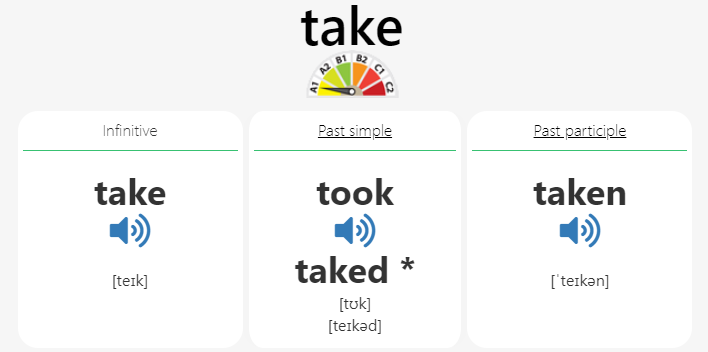
The verb “take” is one of the most commonly used verbs in the English language. Today we will show you how to use this word correctly. Irregular verb forms need to be memorized, and unfortunately the verb “take” is one of those irregular verbs.
TAKE verb forms
| Infinitive | Past Tense | Past Participle |
| Take /teɪk/ | Took / tʊk/ | Taken / teɪkən |
Past tense: ‘took’
The verb “take” is an irregular verb. It is therefore necessary to know all of its forms. The so-called 2nd form of this verb (past tense of take) is “took” / tʊk /. Pay particular attention to its pronunciation, we’ll pronounce it shortly!
The tense “took” is used only in the past simple as it expresses an action that has already happened. The action could happen just once or it can happen repeatedly. For the past simple, we do not distinguish the singular or the plural form of the verb, nor do we distinguish it in the 3rd person.
In the past simple, it is necessary to distinguish the positive and negative meaning of a sentence.
While the verb “took” is used only in positive sentences, it must be combined with additional verbs if used in a negative sentence. For negative sentences, it is necessary to combine the infinitive (original form of the word) “take” with the negative “did not“.
The following example will provide more clarity.
Example:
“I took your bag.” Past Tense
„I did not take your bag.“ infinitive
„She did not take your bag.“ infinitive
Past participle: ‘taken
The 3rd form of the verb (past participle of take) is “taken” / teɪkən /.
Although this is not a commonly used tense, you still need to know it. The form “taken” is used in the past and present perfect and refers to more complex instances in time which are most often expressed in longer sentences.
The past perfect expresses a story that has already happened. It expresses events that happen before a certain point in the past. For the past tense, the additional verb “had” is also used in front of the 3rd form of the verb “taken”.
The following example will provide more clarity.
Look at a TAKE v3 form.
Example:
“I had taken your bag, so you couldn’t find it.”
The above sentence is made up of two parts with different tenses. The first part, “I took your bag“, had happened before a certain point in the past. Because this event happened before a certain point in the past, we use “had taken”.
At first “I took your bag” (past tense), and then “you couldn’t find it” (past perfect).
Past continuous: ‘was/were taking’
The past continuous tense is formed by adding the verb “was” (singular form of the 1st and 3rd person) / “were” (others) and the ending “–ing”.
This tense is used when an action occurred in the past or when the action happened at a certain point in time.
Example:
“I was taking my stuff all night.”
The exact point in time when the action happened is clearly stated in the above example (all night), so we’ll write the verb “take” in the form “was taking“.
From the above, were you able to gain at least a basic understanding of how to use the verb “take” in its past tenses?